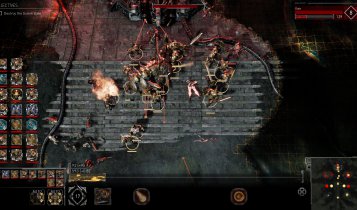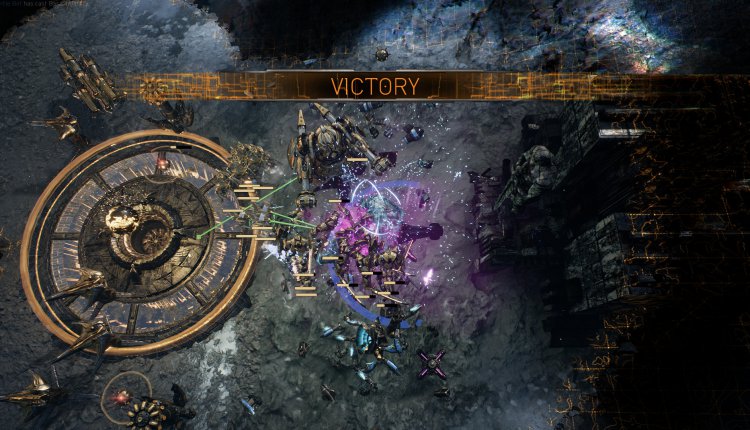I like a lot of game genres, yet am terrible at many of them. One that stands out for me is pretty much any real-time strategy game. When I was younger I played them to death, with Dune II, Command and Conquer and Warcraft 2 being personal favourites. I could demolish the campaigns and could do pretty well in skirmish mode against the computer. Then, when I got older and had ways to play against other people, it suddenly dawned on me that I had no clue what I was doing. Build orders, tank rushes and micro-management were all alien concepts to me — and it showed as I was destroyed over and over. That never really changed, as finding the time to practice to the point of getting genuinely good was something I never felt I had. I still enjoyed playing them though, and now I have one that I feel I can manage much more readily in Golem Gates, currently in Steam Early Access.

Golem Gates is an RTS/collectible card hybrid in which you, as the Harbringer, summon creatures to battle an opposing Harbringer. Battles begin with you playing cards (called glyphs) anywhere your Harbringer can see. These glyphs summon soldiers, turrets, spells, debuffs and other such things to aid in your struggle. All these glyphs cost power, which slowly restores over time up to a certain point, limiting the glyphs you can play early on. By sending your soldiers out onto the battlefield, you can claim nodes that increase your power recovery rate, as well as gradually increase your overall reserve, allowing you access to more powerful glyphs over time. Of course, your opposite number is also trying to do the same thing, leading to clashes over control points and flashpoints as you send troops onwards. Should your Harbringer fall, the game is over.
Card collecting comes in the form of gaining new glyphs at the end of a match. These can then be added to a deck (which has no obvious size limit from the time I spent with it) to customise your playstyle for future matches. If you’ve played any collectible card game in the past, you probably expect cards that work well together, along with a small deck size (to let you get to these combos quickly), are somewhat important — but here a small deck size can be a problem. If you run out of glyphs in a match, you can shuffle them back in, but the penalty for doing so is a short wait in which you can do nothing other than survey the field. If you see your opponent in this situation, you have a perfect opportunity to attack without fear of reprisal for a brief moment. It’s an interesting addition which could result in some interesting strategies online.

During my time with Golem Gates, I played the campaign I had access to (it’s still in Early Access) and some AI skirmishes. I didn’t manage to find a multiplayer game at the time, but I can see that many things could work really well with it, especially in team-based modes. The game is a lot of fun to play as you try to deploy your troops in the right place as they come out of your deck. Resource management is crucial early on when placing units and structures you can only just afford. Do you use all your power to send a small team out to capture a point, or do you spend it on a turret to secure what you already have? There’s plenty of scope for different strategies depending on your deck and situation.
Golem Gates looks beautiful. I mean, utterly stunning at times — and screenshots don’t do it justice. The models have a ton of detail on them, looking fantastic in motion, and the environments look genuinely interesting (especially when covered with the writhing fog of war). Have a look at the game’s website and take a look at how impressive this stuff is. The downside is that battles can get a little crowded when there are numerous small squads battling it out, making it hard to pick out what’s happening and select the right things. There’s also a lack of player feedback when being attacked. Flashpoints do appear on the map, but there’s no obvious sound cue or bright effect to point it out unless your Harbringer is attacked directly. Hopefully, some of this will be sorted out in the final release.
The only other real concern I have is regarding the way you gain glyphs. I assume they’re random at the end of matches, and the fact that they can be crafted is a good move. This does mean that you might not be able to create a deck that genuinely suits you for some time, depending on the glyphs you gain. Having said that, there are plenty of ways to play to gain new cards — playing campaigns with varied objectives, trials for special challenges, survival and versus AI or humans — and matches are fairly quick, so it may not be a major worry.

As it stands, there’s a lot to like about Golem Gates. The visuals are gorgeous, the gameplay is solid and its mechanics are well thought out. It’s a game that deserves to be checked out, even whilst still in Early Access. The final release will have a full campaign, more maps, and cosmetics, which can be unlocked through gameplay — no mention of microtransactions and loot boxes here! The full game is currently due for release in March, so I’ll be returning to it then.
Comments are closed.